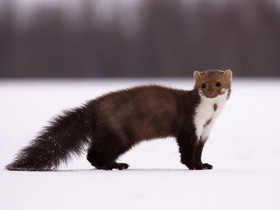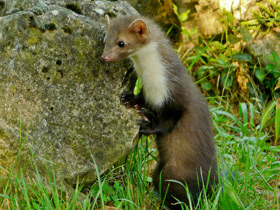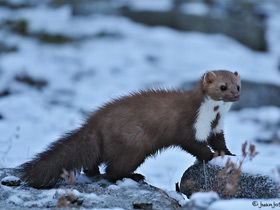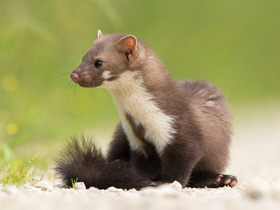The beech marten, the stone marten, house marten or white breasted marten (Martes foina)
The beech marten (Martes foina), also known as the stone marten, house marten or white breasted marten, is a species of marten native to much of Europe and Central Asia, though it has established a feral population in North America. It is listed as Least Concern on the IUCN Red List on account of its wide distribution, its large population, and its presence in a number of protected areas. It is superficially similar to the European pine marten, but differs from it by its smaller size and habitat preferences. While the pine marten is a forest specialist, the beech marten is a more generalist and adaptable species, occurring in a number of open and forest habitats.
Appearance
The marten (Martes foina) is a carnivorous mammal of the family Mustelidae.
Martes foina is the size of a small or slightly larger cat. It differs from ferrets, minks and foals by its short, triangular snout, large (over 3.5 cm) and slightly triangular ears, the absence of white on the lower lip and a light-coloured patch on the chest. Martes foina is very similar to Martes martes, but its tail is even longer (25-35 cm with a body length of 45-54 cm). This species is characterised by a white throat patch (occasionally pale pink), almost always forked underneath and with two stripes extending to the forelegs. The general coat colouring of Martes foina is light, pale brown, with darker tail and legs. Other differences with Martes martes martes are the light coloured nose and the uncoated paws. In addition, the Martes foina is slightly smaller, but heavier than its close relative. These animals reach a body length of 40 to 55 cm and a tail length of 22 to 30 cm. The weight of the Martes foina ranges from 1.1 to 2.3 kg. The Martes foina has the usual physique of its genus, with an elongated, slender torso and relatively short limbs. Its tail is rather long and fluffy.
Habitat
Martes foina inhabits most of Eurasia, its range extending from the Iberian Peninsula to Mongolia and the Himalayas. It is the only member of the genus that does not live exclusively in forests. Martes foina prefers open terrain with isolated shrubs and trees, often stony ground, which is reflected in its name. In the mountains, it can be found up to 4000 m above sea level. It is not afraid to appear near settlements and is often found in parks, barns and attics.
Martes foina are very agile and fast predators, mainly nocturnal. They live in burrows, which they use all year round for resting, and spend most of their time in them during heavy frosts. Martes foina make their dens in a rock crevice, under stones or roots, in attics and, less frequently, in hollow trees. They are good tree climbers, but often hunt on the ground, especially at night.
Lifestyle
Martes foina are mainly active at night and hide in their hiding places during the day. Their natural hiding places are rock crevices, piles of stones and abandoned structures of other animals (Martes foina do not build or dig them themselves). Near their settlements, Martes foina often use attics or barns for this purpose. The nests are lined with hair, feathers or plant material. At night, Martes foina go in search of prey, moving mainly on the ground. Although the Martes foina is good at climbing trees, it rarely does so.
Like most martens, Martes foina are solitary and avoid contact with their relatives outside the breeding season. Each individual has an individual territory, which it marks with a special secret and protects from other Martes foina of its sex. The area of individual patches can vary, but is generally smaller than that of Martes martes martes. It can range from 12 to 210 hectares and depends, among other things, on sex (males have larger patches than females), time of year (winter patches are smaller than summer ones) and prey availability.
Nutrition
Martes foina are omnivorous animals. They hunt small mammals (rodents, rabbits), birds and their eggs, frogs, insects and others. In summer, an important part of their diet is vegetable food, including berries and fruits. Occasionally Martes foina will enter poultry houses or lofts. The birds' panic attacks have a predatory reflex, causing them to kill as much prey as possible, even if their numbers far exceed what they can eat. Urban Martes foina feed mainly on pigeons, mice and rats that spend the night in attics.
Reproduction
Martes foina mate in summer, but they have a long latency phase of gestation, so that the young appear almost a year later, in late spring. Thus, a full eight months elapse between mating and parturition, while the actual pregnancy lasts only one month. Three or four cubs are usually born at a time (but there may be 1 to 8), which are blind and naked at first. They will see at 30-36 days, begin to leave the nest at one and a half months of age and the female will feed them with milk for an average of two months. In autumn, the young become independent and reach sexual maturity between 15 and 27 months of age. The average life expectancy of Martes foina in the wild is only three years, with the most successful individuals surviving to ten years. However, in captivity, Martes foina live much longer and have lived up to 18 years.
Subspecies
The following subspecies are recognised:
- Martes foina foina;
- Martes foina bosniaca;
- Martes foina bunites;
- Martes foina kozlovi;
- Martes foina intermedia;
- Tuesday foina mediterranea;
- Tuesday foina milleri;
- Tuesday foina nehringi;
- Tuesday foina rosanowi;
- Tuesday foina syriaca;
- Tuesday foina toufoeus.
Relationships with other predators
In areas where the beech marten is sympatric with the pine marten, the two species avoid competing with one another by assuming different ecological niches; the pine marten feeds on birds and rodents more frequently, while the beech marten feeds on fruits and insects. However, in one known case, a subadult beech marten was killed by a pine marten. The beech marten has been known to kill European polecats on rare occasions. Red foxes, lynxes, mountain lions, golden eagles, and Eurasian eagle-owls may prey on adults, and juveniles are vulnerable to attack by birds of prey and wildcats. There is, however, one case, from Germany, of a beech marten killing a domestic cat.
Tameability
British zoologist George Rolleston theorised that the "domestic cat" of the Ancient Greeks and Romans was in fact the beech marten. Pioneering marine biologist Jeanne Villepreux-Power kept two tame beech martens.
Hunting and fur use
Although the beech marten is a valuable animal to the fur trade, its pelt is inferior in quality to that of the pine marten and sable. Beech marten skins on the fur markets of the Soviet Union accounted for only 10-12% of the market presence of pine marten skins. Beech martens were caught only in the Caucasus, in the Montane part of Crimea and (in very small numbers) in the rest of Ukraine, and in the republics of Middle Asia. Because animals with more valuable pelts are rare in those areas, the beech marten is of value to hunters on the local market. Beech martens are captured with jaw traps, or, for live capture, with cage traps. The shooting of beech martens is inefficient, and trailing them with dogs is only successful when the animal can be trapped in a tree hollow.
Car damage
Since the mid-1970s, the beech marten has been known to occasionally cause damage to cars. Cars attacked by martens typically have cut tubes and cables. The reason for this behaviour is not fully known, as the damaged items are not eaten. There is, however, a seasonal peak in marten attacks on cars in spring, when young martens explore their surroundings more often and have yet to learn which items in their habitat are edible or not.



















































